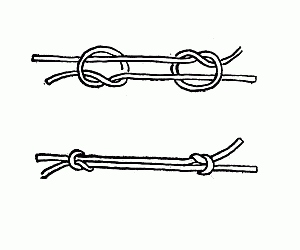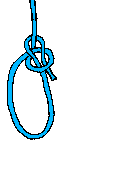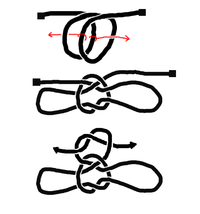Fishermans knot
The Fisherman's knot is a specialized bend. It consists of two overhand knots wrapped around each other.
It requires little dexterity to tie, so is often used in stubborn materials. When tightened, it becomes fairly compact, and the free ends can be cropped very close to the knot. These qualities make it very useful for fishing line--it is less likely to jam a fishing rod than many other bends, and is easier to tie with cold, wet hands.
To tie the fisherman's knot, lay the two ends to be tied alongside each other and facing opposite ways. Tie an overhand knot on the first rope and pass the second rope through the loop formed. Tighten the overhand knot, to prevent the line inside it from flopping around. Then tie another overhand knot on the second rope with the first rope passing through it.
There are so many, many knots available to us all. There are three specific knots that I will talk about here.
This knot can tie two ropes or two ends of a rope together.
This knot is used to tie a non-slip loop on the end of a rope
I think the usage of this handcuff knot is self-explanatory
The name of the game is "Bondage and Discipline", not "Cuffs and Discipline". Bondage is an elemental part of B&D sessions. If you are insecure about your knot-tying abilities, your client will definitely notice it.
These three knots above should be considered 'bare minimum requirements' for anyone wishing to do sessions. For safety reasons, you should also be able to tie and untie them in the dark.
See also Curricula and/or Rope and Knot terms

|
This article is about either
|
What links here • References and Sources • Contact info • Category:Root ⤴



